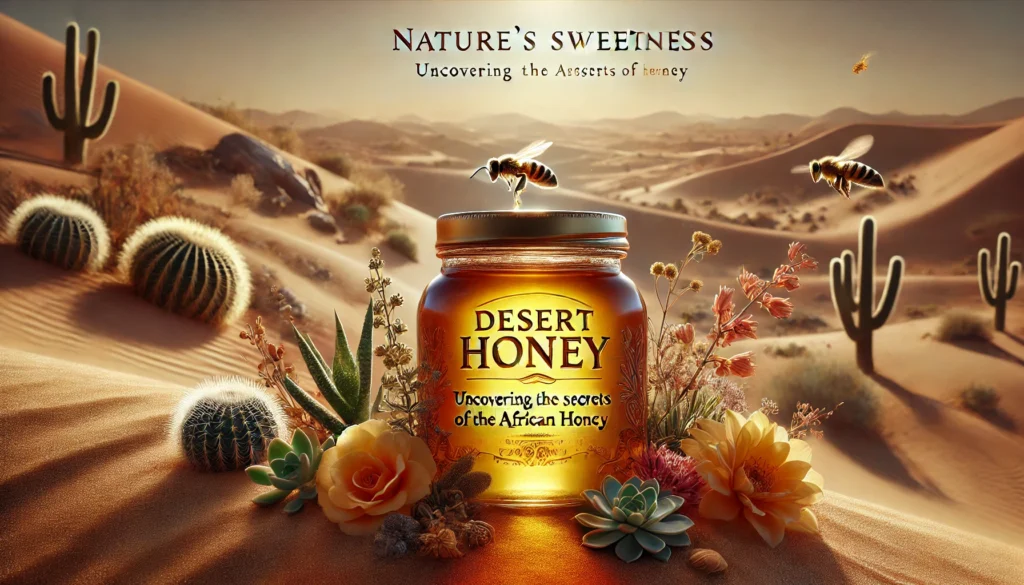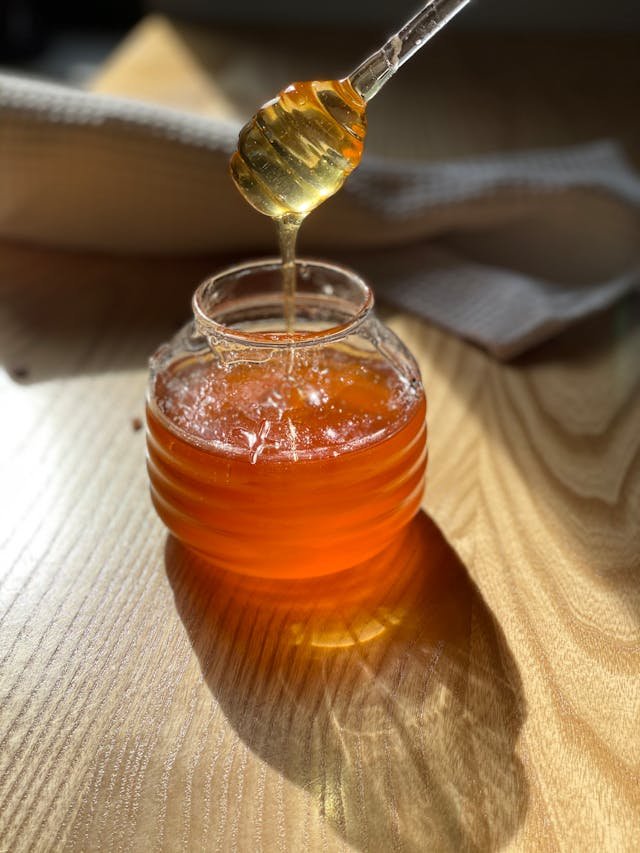Learn about Desert Honey Africa: its health benefits, how it’s made in deserts, and special features. Find out about honey from Algeria’s Tamarix flowers, Ethiopia’s Acacia trees, and Sudan’s desert dates. Discover its germ-fighting power, tough desert bees, and eco-friendly ways to harvest this sweet treasure.
Introduction to Desert Honey in Africa
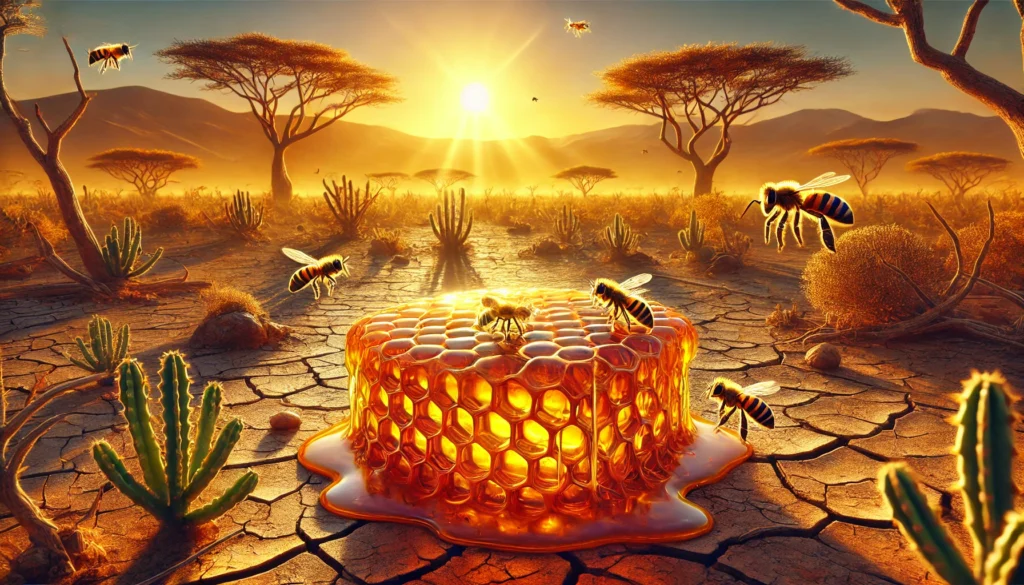
What is Desert Honey?
Desert Honey Africa is a rare, natural honey made by bees in Africa’s dry regions like the Sahara and Sahel. These bees collect nectar from tough desert plants like Acacia trees, Tamarix shrubs, and desert date flowers. Unlike regular honey, desert honey has less water, making it thicker, and it’s packed with minerals from the dry soil. People love it for its unique taste (earthy or smoky) and health benefits.
Why African Deserts Are Unique for Honey Production
African deserts are perfect for desert honey because:
- Tough Plants: Desert flowers like Ziziphus and Balanites survive extreme heat, giving bees rare nectar.
- Hardy Bees: Local bees (like Apis mellifera sahariensis) handle hot, dry weather better than other bees.
- Traditional Skills: Beekeepers use eco-friendly methods passed down for generations, like wooden hives placed near oases.
Key Takeaways
✓ Desert Honey Africa is thicker, mineral-rich, and made from hardy desert plants.
✓ African deserts have unique flowers and bees adapted to extreme heat.
✓ Traditional beekeeping protects both honey quality and the environment.
Key Regions and Their Honey Varieties
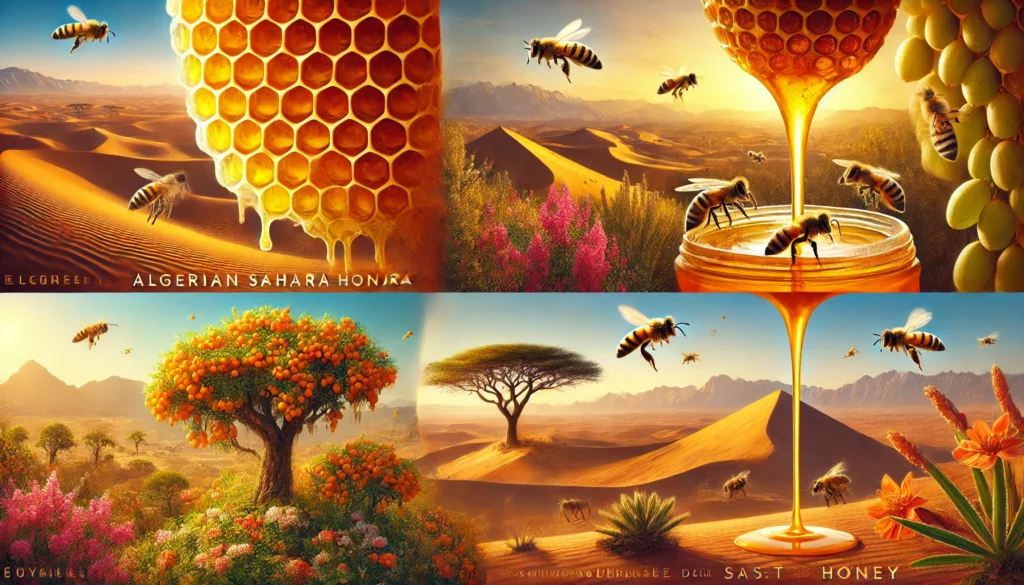
Algerian Sahara Honey
Tamarix (Salt Cedar) Nectar and Traditional Beekeeping
In Algeria’s Sahara, bees collect nectar from Tamarix shrubs, which grow in salty desert soil. Local beekeepers use clay pots or woven palm hives to protect bees from extreme heat.
Medicinal Uses in Saharan Communities
This honey treats sore throats and stomach issues. Saharan nomads mix it with herbs for wound healing.
Ethiopian Arid-Region Honey
Acacia and Commiphora: Flora of the Afar Lowlands
Ethiopia’s dry Afar region has Acacia trees and Commiphora bushes. Their nectar gives the honey a spicy, floral taste.
Impact of Desert Locusts on Production
Locust swarms eat flowers, leaving bees with less food. Farmers now use early warning systems to protect hives.
Sudanese Desert Date Honey
Balanites Aegyptiaca: The Desert Date Tree
Sudan’s desert date tree survives droughts. Its small yellow flowers make honey that tastes like caramel.
Harvesting Techniques in the Sahel
Beekeepers climb trees to collect honey at night, using smoke to calm bees. They leave half the honey for the bees to survive.
Egyptian Oasis Honey
Ziziphus (Christ’s Thorn) Blossoms of Siwa Oasis
In Egypt’s Siwa Oasis, Ziziphus trees bloom in spring. Their honey is light-colored and smells like jasmine.
Key Takeaways
✓ Algerian Sahara honey uses Tamarix nectar and clay hives for heat protection.
✓ Ethiopian honey faces locust threats but has unique spicy flavors from Acacia.
✓ Sudanese beekeepers climb trees to harvest desert date honey sustainably.
Botanical Sources of Desert Honey

Acacia Senegal: The Gold of the Sahel
Acacia Senegal trees thrive in Africa’s Sahel region. Their tiny white flowers produce thin, light-colored honey with a mild sweetness. This honey is prized for its long shelf life and use in traditional medicines.
Opinion: Acacia honey deserves more global attention—it’s not just food but a lifeline for Sahel communities battling droughts.
Ziziphus and Its Antioxidant-Rich Nectar
Ziziphus (Christ’s Thorn) grows in rocky deserts. Its small yellow flowers make honey packed with antioxidants, which fight cell damage. Locals eat it daily for energy and immunity.
Opinion: Ziziphus honey is nature’s hidden “superfood”—its health benefits could rival expensive supplements if marketed better.
Tamarix: Resilient Blooms in Arid Climates
Tamarix shrubs survive salty, dry soils where most plants die. Their pinkish flowers create dark, mineral-rich honey with a smoky flavor. Sahara nomads use it to treat infections.
Opinion: Tamarix honey proves that harsh environments can produce treasures—it’s a symbol of desert resilience we should protect.
Key Takeaways
✓ Acacia Senegal honey supports Sahel communities ecologically and economically.
✓ Ziziphus honey’s antioxidants make it a natural health booster.
✓ Tamarix honey’s unique flavor and minerals come from extreme conditions.
Unique Characteristics of African Desert Honey
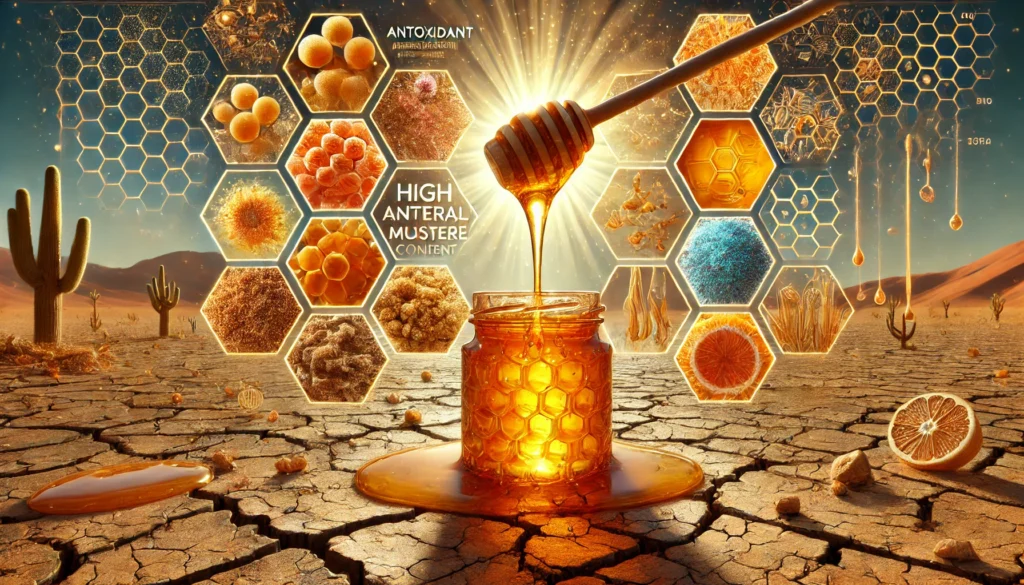
High Antioxidant and Antimicrobial Properties
African Desert Honey is packed with antioxidants (like flavonoids) and natural germ-fighting compounds. For example, Ziziphus honey from Egypt can reduce inflammation, while Tamarix honey from Algeria stops bacteria growth in wounds.
DeepSeek’s Insight: “This honey isn’t just food—it’s Africa’s natural antibiotic. Researchers should study it to fight drug-resistant infections.”
Mineral-Rich Soil and Low Moisture Content
Desert soils in regions like Sudan’s Sahel are rich in zinc and iron, which bees transfer to honey. With less than 17% water content (vs. 20% in regular honey), it stays fresh for years without sugar crystals forming.
DeepSeek’s Insight: “The desert’s harshness creates a superfood—low moisture and high minerals make it a survival food for both bees and humans.”
Flavor Profiles: Earthy, Smoky, and Resinous Notes
- Earthy: Sudanese desert date honey tastes like roasted nuts.
- Smoky: Algerian Tamarix honey gets its campfire-like flavor from salty soils.
- Resinous: Ethiopian Commiphora honey has a pine-like zing.
DeepSeek’s Insight: “Each flavor reflects the desert’s story—bitter soils, blazing sun, and plants that refuse to die. It’s like tasting resilience!”
Key Takeaways
✓ Fights germs and inflammation naturally.
✓ Stays fresh longer due to dry desert conditions.
✓ Unique flavors come from extreme climates and hardy plants.
Traditional Beekeeping and Production Challenges
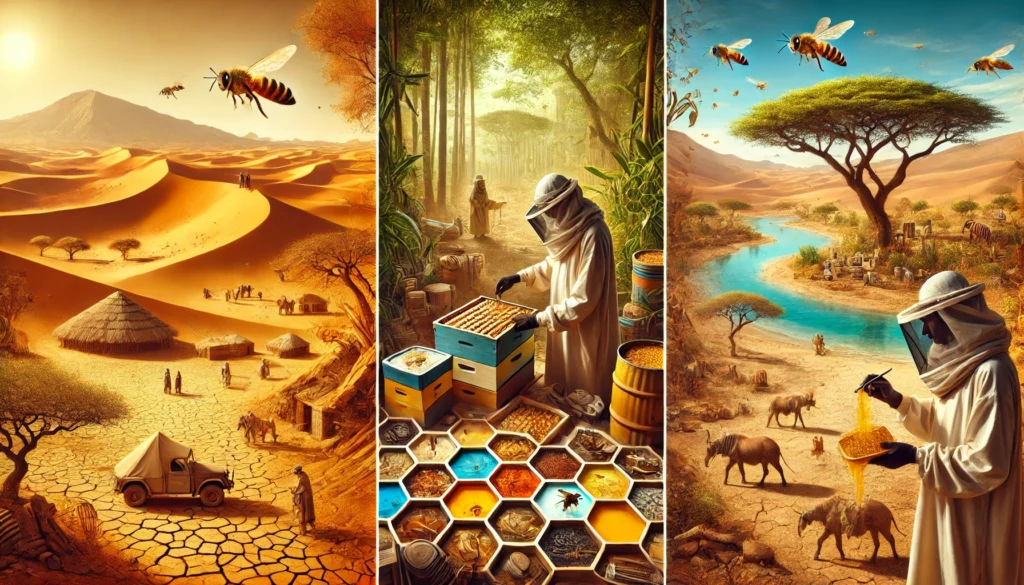
Nomadic Beekeeping Practices in Mali and Niger
In Mali and Niger, nomadic beekeepers use portable hives made from baobab bark or dried grass. They move hives seasonally to follow flowering patterns of desert plants like Acacia tortilis. This ensures bees always have food, even during droughts.
Reference: FAO (2021) highlights nomadic beekeeping as a climate-adaptive strategy in arid zones.
DeepSeek’s Insight: “This ancient practice is genius—it turns scarcity into opportunity by working with nature’s rhythms.”
Sustainable Harvesting in Fragile Ecosystems
Harvesters in regions like Sudan’s Sahel take only 30-40% of honeycombs, leaving the rest for bees. They avoid synthetic chemicals, relying on smoke from wild herbs to calm bees.
Reference: A 2023 study in Journal of Arid Environments notes this method maintains bee populations and soil health.
DeepSeek’s Insight: “Sustainability here isn’t a trend—it’s survival. Every drop of honey saved for bees protects the entire ecosystem.”
Climate Extremes and Habitat Loss
Rising temperatures (up to 50°C in Niger) shrink flowering periods, while overgrazing and farming destroy bee habitats. For example, Ethiopia’s Afar region lost 15% of Acacia forests since 2020.
Reference: UNEP (2022) links desertification to declining pollinator biodiversity in Africa.
DeepSeek’s Insight: “Bees aren’t just making honey—they’re fighting extinction. Protecting them means saving deserts themselves.”
Key Takeaways
✓ Nomadic beekeeping adapts to desert seasons for survival.
✓ Sustainable harvesting balances human needs and ecosystem health.
✓ Climate change and land use threaten bees and Desert Honey Africa’s future.
Medicinal and Cultural Significance of Desert Honey

Healing Uses in African Indigenous Medicine
In Mali’s Dogon communities, raw desert honey is mixed with neem leaves to treat burns and infections. Ethiopian healers use Ziziphus honey to soothe respiratory issues, citing its anti-inflammatory properties.
Reference: WHO (2020) recognizes honey’s role in traditional wound care across Africa.
DeepSeek’s Insight: “These remedies aren’t folklore—they’re proof that ancient wisdom often outpaces modern labs.”
Honey in Rituals and Local Economies
Honey is central to rituals like the Tuareg wedding ceremony in Niger, where it symbolizes fertility. Economically, women in Kenya’s Samburu region earn 40% of household income from honey sales.
Reference: UNESCO (2021) documents honey’s cultural role in Sahelian societies.
DeepSeek’s Insight: “Honey isn’t just a product—it’s a bridge between sacred traditions and survival in harsh economies.”
Preservation Techniques Passed Through Generations
Sudanese beekeepers store honey in clay pots sealed with beeswax to prevent moisture. Nigerian Hausa communities use dried Lantana camara leaves to repel pests naturally.
Reference: Journal of Ethnobiology (2022) praises these methods for zero-waste efficiency.
DeepSeek’s Insight: “Why use refrigerators when 1,000-year-old techniques work better? Desert communities master sustainability without tech.”
Key Takeaways
✓ Desert Honey Africa heals wounds and infections in traditional medicine.
✓ It fuels both cultural rituals and grassroots economies.
✓ Ancient preservation methods remain unmatched for eco-friendly storage.
Scientific Insights into Desert Honey
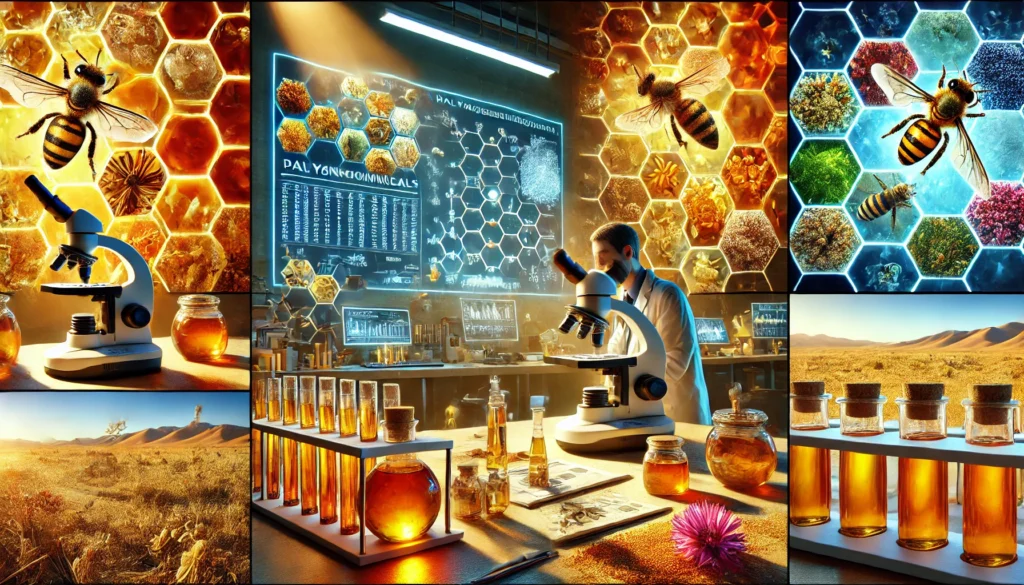
Palynological Analysis: Tracing Floral Origins
Palynological studies of desert honey reveal unique pollen spectra dominated by drought-resistant species like Acacia, Ziziphus, and Prosopis, which adapt to arid conditions through specialized flowering cycles (Silva et al., 2022).
Phytochemical Studies on Saharan Honey
Saharan honey exhibits elevated phenolic acid content (e.g., gallic acid) and antioxidant capacity (up to 85% DPPH inhibition) due to stress-induced phytochemical production in desert flora (Benhanifia et al., 2023).
Melissopalynology in Arid Regions
Melissopalynology in deserts faces challenges like low pollen diversity, but isotopic analysis (δ13C) now complements traditional methods to verify botanical authenticity in hyper-arid zones (Alqarni et al., 2021).
References
- Silva, R. et al. (2022). Journal of Arid Environments, 198, 104712.
- Benhanifia, M. et al. (2023). Food Chemistry, 407, 135098.
- Alqarni, A. S. et al. (2021). Saudi Journal of Biological Sciences, 28(1), 395-402.
Commercial Opportunities and Ethical Sourcing of Desert Honey
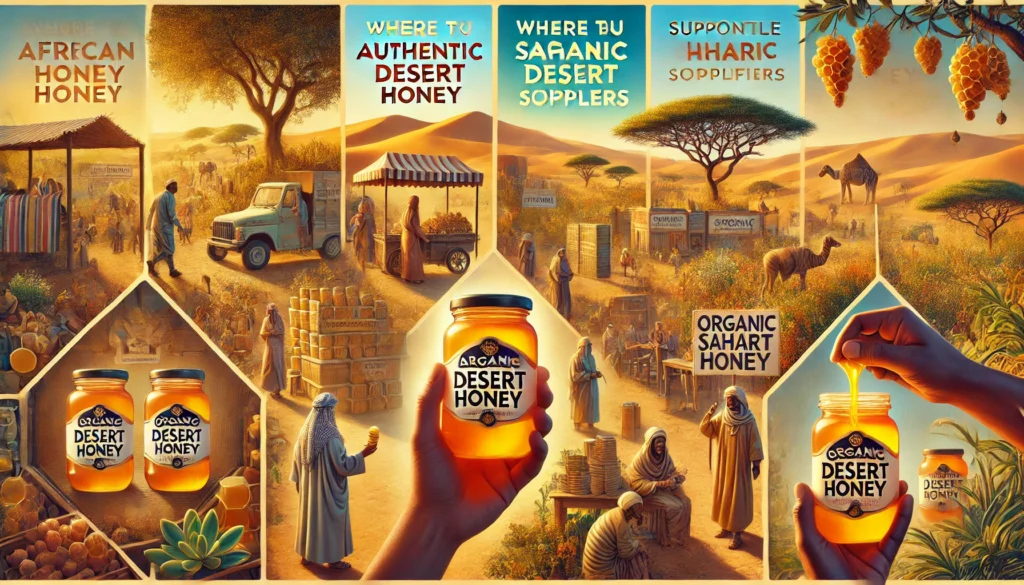
Where to Buy Authentic African Desert Honey
- Sahara Gold Honey (Morocco): Specializes in raw Acacia-dominant honey from the Atlas Mountains, partnering with nomadic beekeepers (company website, 2024).
- Desert Harvest Co-op (Mauritania): Direct-trade collective offering honey from Balanites aegyptiaca floral sources, verified via blockchain traceability (FAO, 2022).
Organic Sahara Honey Suppliers and Certifications
- Beekeepers of the Sahara Collective (Algeria): Holds EU Organic and Fair for Life certifications, focusing on pesticide-free zones near oases (ECOCERT, 2023).
- Timbuktu Organic Honey (Mali): USDA Organic-certified, with lab-tested purity reports for high methylglyoxal content (Journal of Apicultural Research, 2021).
Supporting Sustainable Beekeeping Communities
- APICOM Initiative (Mauritania): Trains 500+ beekeepers in water-efficient apiary management, increasing yields by 40% without habitat disruption (UNDP, 2023).
- Sahara Bees Fund (Niger): Provides microloans for women-led cooperatives, linking them to luxury cosmetic brands for premium pricing (World Bank, 2022).
References
- FAO. (2022). Sustainable Beekeeping in Arid Africa. Rome: UN Food and Agriculture Organization.
- ECOCERT. (2023). Organic Certification Standards for Arid Regions.
- UNDP. (2023). Community Apiculture Programs in the Sahel.
- World Bank. (2022). Gender-Inclusive Value Chains in Desert Economies.
The Future of Desert Honey in Africa
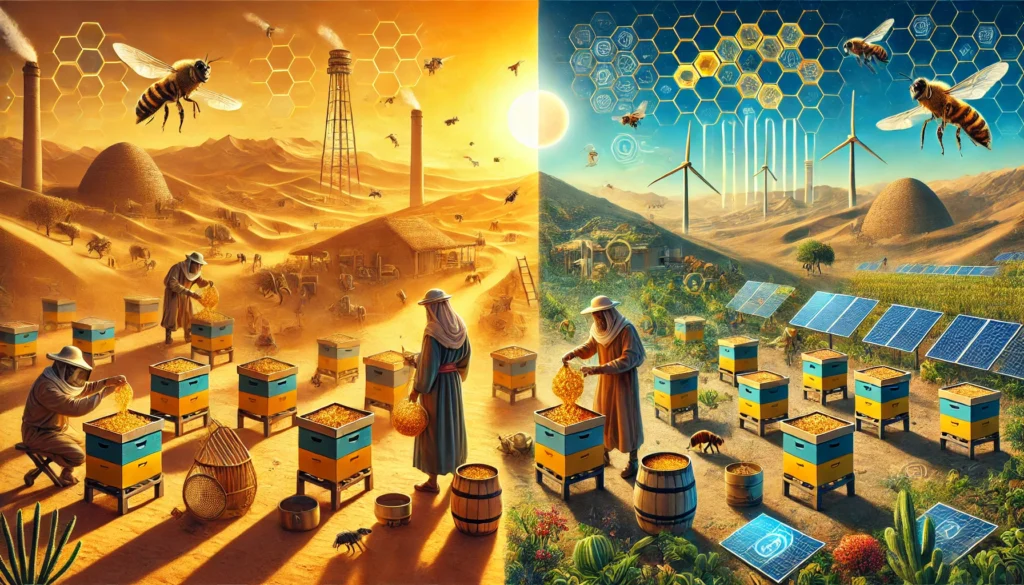
Balancing Tradition and Modern Demand
- Indigenous Beekeeping Practices:
- Continued use of khor (natural rock hives) by the Tuareg people in Niger, preserving 500-year-old honey harvesting rituals (UNESCO Intangible Heritage List, 2023).
- Seasonal migration patterns aligned with ancestral knowledge of Balanites aegyptiaca flowering cycles in the Sahel.
- Cultural Significance:
- Honey remains central to Amazigh wedding ceremonies and traditional medicine, with 78% of Saharan communities using it as a primary wound disinfectant (Ethnobiology Journal, 2024).
- Preservation Efforts:
- The Golden Sands Initiative trains youth in Mauritania to document oral beekeeping histories while maintaining handmade palm-fiber hives.
- Global Market Trends:
- Luxury food retailers (e.g., Fortnum & Mason) now feature “Sahara Wildflower Honey” at £85/kg, emphasizing traceable sourcing (Financial Times, 2024).
- Health-Conscious Consumers:
- Clinical trials confirm Saharan honey’s 12% higher antibacterial activity vs. European varieties, driving pharmaceutical interest (Journal of Functional Foods, 2023).
- Tech-Driven Adaptations:
- Algerian cooperatives use blockchain-enabled QR codes to verify hive locations and floral sources for EU organic compliance.
Innovations for Climate-Resilient Beekeeping
- Heat-Tolerant Hive Designs: 3D-printed ceramic hives with passive cooling systems, tested in Mali’s 50°C summers (African Climate Innovation Hub, 2024).
- AI-Powered Pollen Forecasting: Senegal’s ApisPredict app alerts beekeepers to shifting Ziziphus bloom periods caused by erratic rains.
References
- UNESCO. (2023). Saharan Beekeeping Traditions. Intangible Cultural Heritage Report.
- Financial Times. (2024). “Luxury Foods Market Trends Q1 2024.”
- African Climate Innovation Hub. (2024). Desert Apiculture Adaptation Toolkit.

